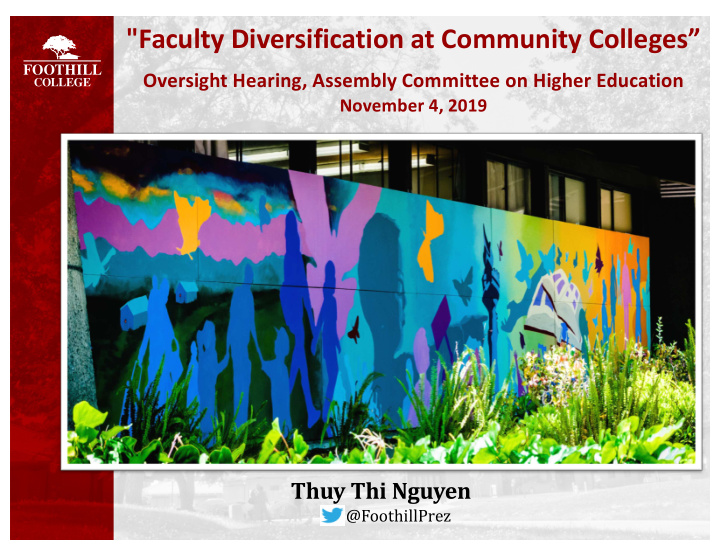



"Faculty Diversification at Community Colleges” Oversight Hearing, Assembly Committee on Higher Education November 4, 2019 Thuy Thi Nguyen @ FoothillPrez
Diversity Benefits Students Studies prove the educational benefits of a diverse faculty. Closing achievement gaps by 19-51% Fairlie, R. W., Hoffman, F., Oreopoulos, P. (2014). A Community College Instructor Like Me: Race and Ethnicity Interactions in the Classroom. American Economic Review .
Key Questions Do underrepresented minority students perform better in courses n taught by minority instructors? Do African-American students do better in courses taught by n African-American instructors? Do Latino students do better in courses taught by Latino n instructors? How much does this represent the achievement gap? n
How Large are Effects Relative to Achievement Gap? Underrepresented Minority White-Min. Similar A chievement Percent of Minority Instructor E ffect Gap Gap B ase Rate -0.020 -0.039 51% 0.281 Dropped Course 0.012 0.054 23% 0.835 Passed Course 0.054 0.318 19% 2.587 Course Grade 0.024 0.112 21% 0.567 Grade Bor Higher
Conclusions Strong, positive and robust minority-interaction effects for all n outcomes examined (including long-term outcomes) Strong, positive own-race interactions n – African-Americans seem to have largest gains Evidence for students reacting to instructors rather than vice n versa – Role model effects, take additional courses and majors – Focus on courses with more objective grading More details, full article n – http://people.ucsc.edu/~rfairlie/papers/
Institutional Effectiveness
Non-Discrimination Laws & Proposition 209 1996 ballot measure, amended the CA Constitution “[T]he state shall not discriminate against, or grant preferential treatment to, any individual or group on the basis of race, sex, color, ethnicity, or national origin in the operation of public employment, public education, or public contracting.” Cal. Const., art. I, § 31, subd. (a)
Two Sides of the Same Coin Nondiscrimination EEO Laws Laws Prohibit Promote Discrimination Inclusion
Laws Promoting Inclusion / Equal Employment Opportunities “a work force that is continually responsive to the needs of a diverse student population [which] may be achieved by ensuring that all persons receive an equal opportunity to compete for employment and promotion within the community college districts and by eliminating barriers to equal employment opportunity .” Education Code, Section 87100
Laws Promoting Inclusion / Equal Employment Opportunities Establishing and maintaining a richly diverse workforce is an on-going process that requires continued institutionalized effort. – “Richly Diverse Workforce” – “Continued Institutionalized Effort” – “Establishing and Maintaining” California Title 5, Section 53024.1
Search Committee Screening/selection committee shall be trained on: (a) federal and state law , including Title 5; (b) the educational benefits of workforce diversity; (c) the elimination of bias in hiring decisions; and (d) best practices in serving on a selection/screening committee. California Title 5, Section 53003(c)
Legal Opinion
A College President’s Perspective • Promote Implicit Association Test (IAT), trainings, and strategies to lower bias • Monitor • Longitudinal data • Integrate with Student Equity Plan • Focus also on part-time faculty • Share responsibilities by all faculty • Fund for new faculty hires
Recommend
More recommend